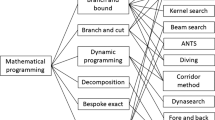Abstract
In this paper we introduce the parametric minquantile problem, a weighted generalisation ofkth maximum minimisation. It is shown that, under suitable quasiconvexity assumptions, its resolution can be reduced to solving a polynomial number of minmax problems.
It is also shown how this simultaneously solves (parametric) maximal covering problems. It follows that bicriteria problems, where the aim is to both maximize the covering and minimize the cover-level, are reducible to a discrete problem, on which any multiple criteria method may be applied.
Similar content being viewed by others
References
M. Avriel, W.E. Diewert, S. Schaible and I. Zhang,Generalized Concavity (Plenum, New York, 1988).
E. Carrizosa and F. Plastria, “Polynomial algorithms for parametric minquantile and maxcovering planar location problems,” Working Paper, BEIF/47, Vrije Universiteit Brussel (Brussels, 1992).
E. Carrizosa and F. Plastria, “The determination of a least quantile of squares regression line for all quantiles,”Computational Statistics and Applications (1995), forthcoming.
V.F. Demyanov and V.N. Malozemov,Introduction to Minmax (Dover, New York, 1990).
Z. Drezner, “On minimax optimization problems,”Mathematical Programming 22 (1982) 227–230.
E. Erkut, “Inequality measures for location problems,”Location Science 1 (1993) 199–217.
P.C. Fishburn,Utility Theory for Decision-Making (Wiley, New York, 1970).
A.M. Geoffrion, “Stochastic programming with aspiration or fractile criteria,”Management Science 13 (1967) 672–679.
R. Keeney and H. Raiffa,Decisions with Multiple Objectives; Preferences and Value Trade-offs (Wiley, New York, 1976).
F. Plastria, “Continuous location problems and cutting plane algorithms,” Ph.D. Thesis, Vrije Universiteit Brussel (Brussels, 1983).
J. Puerto, “Programacion multiple ordenada,” Ph.D. Thesis, University of Sevilla, Spain (Sevilla, 1990).
J. Rawls,A Theory of Justice (Harvard University Press, Cambridge, MA, 1971).
P.J. Rousseeuw, “Least median of squares regression,”Journal of the American Statistical Association 79 (1984) 871–880.
B. Roy, The outranking approach and the foundations of ELECTRE methods, in: C.A. Bana e Costa, ed.,Readings in Multiple Criteria Decision Aid (Springer, Berlin, 1990) pp. 155–183.
A. Sen,On Economic Inequality (Clarendon, Oxford, 1973).
F.A. Valentine,Convex Sets (Krieger, New York, 1976).
D.J. White,Optimality and Efficiency (Wiley, New York, 1982).
Author information
Authors and Affiliations
Additional information
Corresponding author.
Visiting researcher at the Center for Industrial Location of the Vrije Universiteit Brussel during this research.
Rights and permissions
About this article
Cite this article
Carrizosa, E., Plastria, F. On minquantile and maxcovering optimisation. Mathematical Programming 71, 101–112 (1995). https://doi.org/10.1007/BF01592247
Received:
Revised:
Issue Date:
DOI: https://doi.org/10.1007/BF01592247




